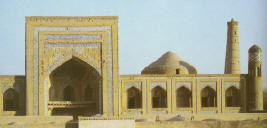
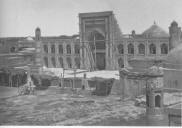


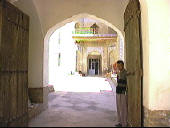

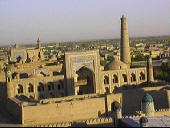
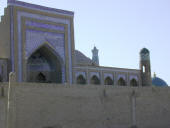
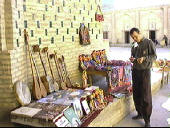

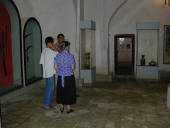

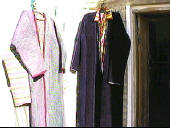
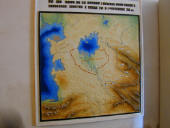
3D map of Khorezm
This map shows the boundaries of the Khorezm Empire before the Russian take-over. Notice how the territory stretches all the way to the Aral Sea.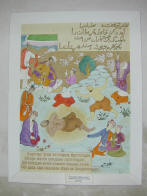
Painting of Pakhlavan Mahmoud's wrestling match
Khiva's famous strongman, Pakhlavan Mahmoud, was reputed to have lost only one wrestling match and even this was done deliberately to save the life of his opponent, an Indian slave condemned to death should he be defeated. The strongman lifted the slave above his head and then fell to the ground with the slave on top of him, ensuring the fortunate slave instant victory.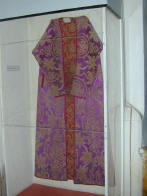
Woman's halat
After a young woman married, her father would present her with a long jacket like this as a sign of her new status. She would wear it with a 'paranja' (veil) on top.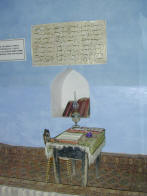
Feruz's Study
Feruz Khan was an ardent poet and spent long hours composing his own verses and appreciating those of others. From his foreign excursions he brought back a couple of printing presses in an effort to produce new reading materials after the Russians swiped his library in the 1870's. His first electric printing press was a non starter, there being no electricty in the oasis at the time. However a second hand-powered one from Iran worked a treat and printed several biiks of poetry and other works.Silk Turkoman Carpet
The silk carpet hanging on the wall is worth closer inspection for its unique design which incorporates the different motifs of the six Turkoman tribes that submitted to the Khan's rule.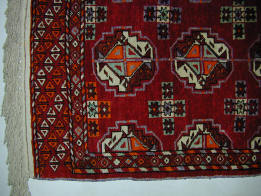
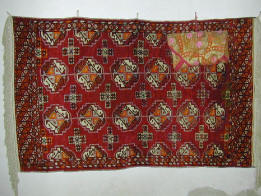
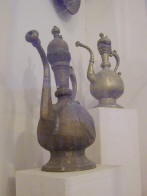
Water Jugs
It's hard to believe that these excellent water jugs, exhibited in the USA in 1884, were made by two young slave-apprentices hoping to pass their metalwork exam. The one on the left was designed by a slave from Kokand and shows the typical Kokand shape with the engravings of Khiva. The other jug is also fashioned after the Kokand shape but is decorated with the patterns of its owner's Indian birthplace. Compare these with the other water jugs dotted around this and other museums which are made in the Khorezm style. They are shaped like an apricot kernel or the curves of a woman's figure and are distinct in their handle-less design.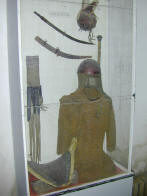
Armour
Here are several moth-eaten examples of seventeenth century armour including the ladle-shaped container which was used to carry the soldier's 'piola' (eating and drinking bowl).Engraved Dish and Interesting Shoes
This circular dish is engraved with the apt Persian proverb, 'Don't eat much, don't ask much, don't talk much!'. Next to the dish lie two pairs of interesting shoes. The woman's petite slip-ons are around two hundred years old while the man's huge clodhoppers were made only a hundred years ago. But why the vast difference in size? Read the story to find out:.. Beauty and the Beast
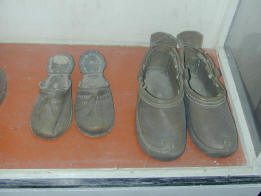
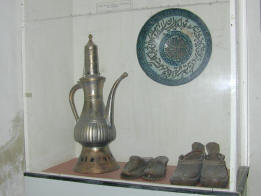
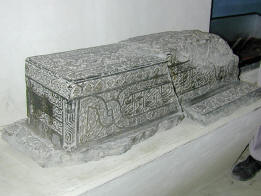
Gravestone
This seventeenth century gravestone was commissioned for Isfandir Khan I and shows Arabic engraving along its length and Persian script along its breadth.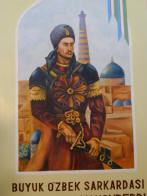
Jallaladin Menguberdi Billboard
Jallaladin Menguberdi was a thirteenth century Khorezm warlord whose claim to fame was his courageous and stubborn resistance against Genghis Khan and his brutal Mongol hordes. Despite crushing defeats, Jallaladin continued to fight back again and again, eventually losing the battle but winning Genghis Khan's respect and admiration for his tenacity and mettle.Jallaladin was first nicknamed, 'Minkburnil' meaning 'angry', which was later corrupted to 'Menguberdi'. Today he is viewed as a brave local hero and has an imposing statue and monument to his name in the centre of Urgench. (See Genghis Khan and Khorezm)
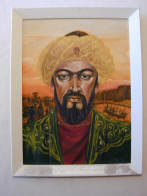
Abdul Gazi Khan
This display contains various books written by the historian, medic, scientist and Khan, Abdul Gazi (1603-1663). Apart from his academic gifts, he was noted for being the only Khan to freely concede the throne to his son, Anusha, while he was still living.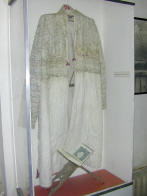
White Embroidered Jacket
This amazing white jacket is covered with tiny, embroidered Koranic verses which incorporate three circles showing the lunar, solar and Muslim calendars.Paintings
Two guns, which were used in Khiva's defence against the Russian conquest of 1873, are displayed alongside a large painting of the Tsar's invaders surrounding the city walls. A mighty army of 12 000 troops armed with the best guns and 250 canons attacking on three sides ensured a swift Russian victory. This was all the more sweet in view of Russia's five previous unsuccessful and bitter attempts to capture the desert city. As a payback for such lengthy and costly resistance, Russia demanded from Khiva four times the amount of tribute exacted from Bukhara. A copy of the resulting treaty drawn up between General Kaufmann and Feruz Khan written in Turkish, Russian and Uzbek is also on show.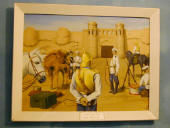
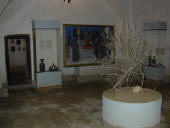
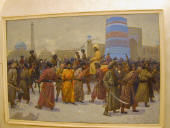
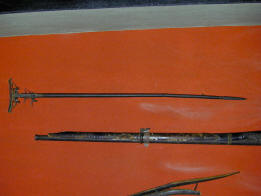
Wonder Weapon
This display contains guns which were presented to the Khans as gifts from various royal rulers. The German king gave Feruz's Grandson, Temur Gazi, a nifty four-in-one 'wonder weapon' which operates as a stick, a dagger, a pistol and a rifle.The First Camera in Central Asia
The first camera in Central Asia belonged to an old German Mennonite with a love for fishing:. Read the story to find out more.Central Asia's First Photographer
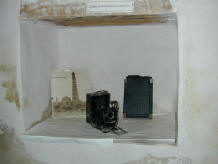
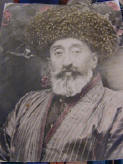
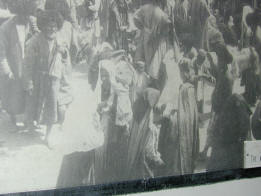
Bazaar Scene
Take a look at this black and white photograph of a crowded bazaar scene which demonstrates some of the intriguing 'inconsistencies' of Khiva's former dress code. Notice, for example, the solitary unveiled woman who probably came from Karakalpakstan or Kazakhstan where covered faces were never obligatory. Notice too, the old man complete with the mandator furry hat walking around in bare feet.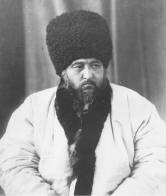
Khans and Viziers
he museum boasts an array of fascinating black and white photos showing Feruz Khan, some of his family and his officials in a variety of straight-faced poses. Look out for portraits of his smooth-skinned son, Isfandir and his twelve-year-old grandson, Temur Gazi, as well as the bearded Vizier, Islam Hoja.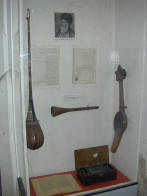
Musical Instruments
Feruz was a keen proponent of the arts and a good friend of the musician, Kamil Khorezmi, who developed a distinct Khorezm melody and captured the tunes of the region in written notation. Several instruments are on display, including a rubab, a surnai, a scripta and a Russian music box.


